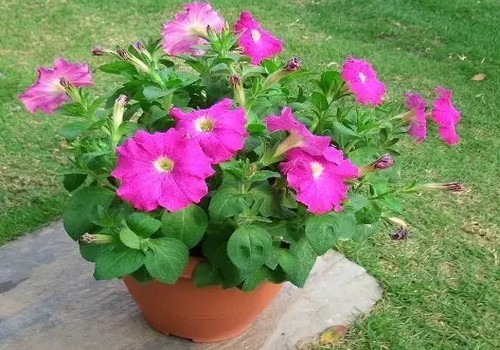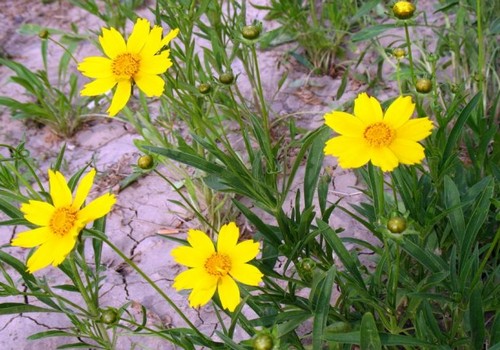Planting method of potted morning glory
Morning glory is an annual herb, the whole plant is covered with white hair, stems and leaves have short hairs, soft and fine. The leaf blade is broad, round or ovate, varying in depth, about 4-15% long and 4.5-14 cm wide. The leaves are slightly hard and loosely pilose. Petiole 2-15 cm long, inserted in inflorescence, varying in length. Bracts leaflike or linear. Corolla is funnel shape, Corolla light color. To grow morning glory scientifically, we must use potted plants. In this way, it is not only convenient for scientific management, but also convenient for exhibition evaluation and comparison, and it is also convenient to ensure the collection of fine varieties.

Potted petunia can also make it do not climb the vine, develop a dwarf clump, rich plant type. When the seedlings grow 5 to 6 leaves, they are planted in a two-cylinder basin with an inner diameter of 23 cm. Then pinched the tip to promote 2 or 3 lateral buds, and erased the rest. When the lateral buds spread the leaves and extend the vine, leave 2 or 3 leaves to tip off. About 10 flowers can blossom at such a time. Take off the flowers immediately after shedding, promote their side branches to sprout again, leave a few, excess erase, and still pinch the tip according to the previous method. In this way, the plants can always be plump and flowers can be kept constantly.
[reproduction]
The sowing time is spring and summer, which is suitable for sowing and planting at 20-25 ℃, and can blossom in summer and autumn. When sowing, soak the seeds in warm water, after 4-6 hours, properly treat with sulfuric acid, sprinkle it in the soil, cover it with thick soil, about 1 cm, keep the soil moist, germinate in about 5-6 days, and transplant after two long leaves.
[raising seedlings]
The germination temperature of morning glory is 20: 30 ℃. Generally, the seeds are sown at the end of April and the beginning of May (in the south, they can be sown in advance). They are sown in fine sandy soil seedbeds according to varieties, and germinate in about 10 days when the humidity is moderate. After about 10 days, the cotyledons are fully open. When the true leaves just germinate, they should be transplanted into a small pot, the seedlings are weak too early and the roots are injured too late, which is not conducive to future development. The small basin should be marked with the variety.
[colonization]
After the seedlings in the small basin grow two or three true leaves, the root system has developed well, so it can be planted in the middle basin and the base fertilizer can be added in advance. As Mr. Mei said, morning glory is not afraid of heavy fertilizer, and horseshoe and cooked hemp dregs can be used as base fertilizer. The root system of morning glory needs temperature to develop, and according to Japanese researchers, it is better to use a black basin to absorb heat than a red one. Should often turn the basin to make the sun shine evenly, so that the root system is fully developed.
[heart-picking]
After three or four true leaves of morning glory grow, the center begins to grow vines, which should be removed at this time. After picking the heart for the first time, there are branches between the axils of the leaves, and after the branches give birth to three or four leaves, they pick the heart again and combine with plastic surgery at the same time. The fertilizer used is similar to that used for chrysanthemums. Be careful not to stain the leaves (including cotyledons) with fertilizer, water and mud, so as not to fall off the leaves. As soon as the vine grows, it enters the flowering stage (usually one month after planting). Ideally, the first leaf of the vine produces axillary buds, and the axils of the second and third leaves send out buds. After the bud is formed, the stipules of the bud can be removed to facilitate the development of the bud. In order to ensure an adequate supply of nutrients and produce large and gorgeous flowers, you can also get rid of some buds and cultivate single flowers, just like cultivating a variety of chrysanthemums. After blooming, you should pick off the residual flowers so as not to make them as children, so as not to affect the nutrition of the next batch of flowers. Of course, after three or four batches of flowers bloom, axillary buds grow, which is difficult to control. General varieties can be planted on the ground, while good varieties are prepared to remain.
[planting]
When petunia is planted, it can sow 4-5 seeds in each pot and break a little heavy skin. Keep the temperature at 25 ℃ and germinate in about 7 days. When the leaves grow out, they can be transplanted to separate the soil from the bracket. When planting morning glory, we should first choose the soil with good drainage, give proper ventilation and sufficient sunshine, irrigate, and apply thin fertilizer once a month to control the nitrogen fertilizer and prevent the stems and leaves from being too luxuriant.
Time: 2019-05-25 Click:
- Prev

Planting method of Chrysanthemum morifolium
Golden rooster chrysanthemum is a common perennial flower, which is very good, but it is not easy to raise it well. It is necessary to have an in-depth understanding of its growth habits. Only in this way can the golden rooster chrysanthemum grow luxuriantly. Friends who like golden rooster chrysanthemum can try to plant it themselves. The yellow flowers of the golden chrysanthemum
- Next

The planting method of six times profit (butterfly flower)
I remember watching pictures of the Aegean Sea on the Internet, every family's yard, walls, and even aisles and alleys were covered with pots of dangling flowers, forming a flower ball along the flowerpot. The deep and shallow blue, the red and green crawling all over the wall and the blue sea in the distance have a great visual impact.
Related
- Fuxing push coffee new agricultural production and marketing class: lack of small-scale processing plants
- Jujube rice field leisure farm deep ploughing Yilan for five years to create a space for organic food and play
- Nongyu Farm-A trial of organic papaya for brave women with advanced technology
- Four points for attention in the prevention and control of diseases and insect pests of edible fungi
- How to add nutrient solution to Edible Fungi
- Is there any good way to control edible fungus mites?
- Open Inoculation Technology of Edible Fungi
- Is there any clever way to use fertilizer for edible fungus in winter?
- What agents are used to kill the pathogens of edible fungi in the mushroom shed?
- Rapid drying of Edible Fungi

